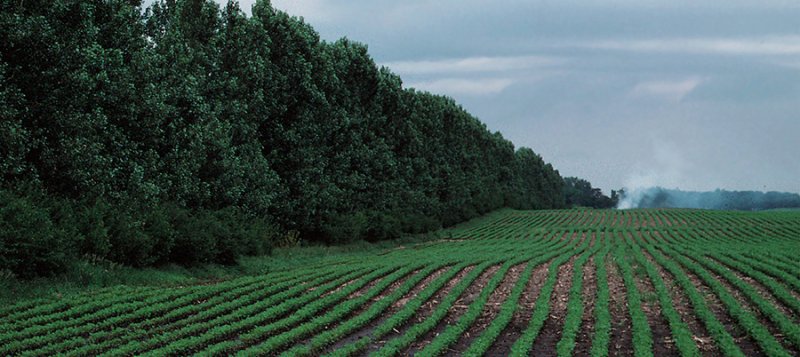Since it began, the MEOPAR project has focused on adaptation to climate change. In our next four blogs, we will examine different approaches to adaptation, which, as a reminder, refers to any adjustment or response to reduce the negative impacts of climate change.
In this blog, we will introduce the concept of Ecosystem-based Adaptation, or EbA for short.
EbA encompasses the various measures that can help both the natural and human components of our ecosystems adapt to climate change. This is achieved by promoting biodiversity conversation, ecological restoration and sustainable resources management. These actions reduce vulnerability and support the development of adaptive capacity and resilience.
The following EbA strategies have been found most relevant to Niagara’s agricultural sector:
Windbreaks: Planting windbreaks, or shelterbelts, is a common EbA practice that has been used by the agricultural sector (especially in Europe) for a very long time. It involves planting shrubs and trees, which can be a mix of deciduous or evergreen (single row or multi-row) crops. Windbreaks are effective as an EbA strategy against strong winds, soil erosion and snow accumulation (through the use of a living snow fence) as they obstruct and alter wind flow patterns resulting in reduced wind speeds. For Niagara, windbreaks can be useful for protecting perennial fruit crops as well as annual crops. It is important to note that windbreaks may involve capital investment and increase maintenance costs, and that the placement of them must be selected carefully in order to avoid competition for nutrients with crops.
Integrated Pest Management (IPM): IPM involves a series of steps that includes the preparation of soil and crop planting, trapping of pests, monitoring and inspection, designing of cultural, biological and chemical controls, and record-keeping that minimizes overall economic, health and environmental risks. IPM also includes the use of pesticides, but only when there is a pest outbreak. In Ontario, IPM has been used extensively for apples (to manage black rots, blister spots, scabs, borers, moth), raspberries (to manage spur blight, cane blight, orange rust), grapes (to control parasitic nematodes), as well as most greenhouse crops. The application of IPM can help maintain ecosystem health and decrease pesticide use as well as the probability of the development of pesticide-resistant insects. In the Niagara region, institutions like Brock University, Niagara College and Niagara Orchard and Vineyard Corporation are actively involved with farmers for IPM research.
Miscellaneous measures: Various other EbA measures have also been identified for Niagara’s agricultural system. For example, intercropping (mixed, row, strip, relay), and crop diversification, with alternate rows or plots of different crops species or varieties, can reduce pre/post-harvest losses and improve resilience to the impacts of climate change (such as higher annual rainfall, average temperatures, and droughts). Other successful EbA techniques include tile drainage, cover cropping (e.g., legumes, white clover), and drought-resistant crops (pearl millets, sorghum) for improved drought resilience and profitability. These techniques are relevant to both field (e.g., soybean and corn) and greenhouse crops. Restoring a pasture into a tallgrass prairie (a natural system originally present in the Niagara) can also help provide fodder to animals during droughts.
 EbA is based on a participatory, integrated and inclusive approach to climate change adaptation. It has the potential to reduce the vulnerability of Niagara’s agricultural system to climate change, and to contribute to the development of a more resilient farming community.
EbA is based on a participatory, integrated and inclusive approach to climate change adaptation. It has the potential to reduce the vulnerability of Niagara’s agricultural system to climate change, and to contribute to the development of a more resilient farming community.
The researchers involved with the MEOPAR project are working to raise awareness about the impacts of climate change and how communities can effectively adapt, and increase resilience, to these changes. Follow along with our blog every week (written by researchers Liette Vasseur, Meredith Caspell, Bradley May, Pulkit Garg, Sam Gauthier & Jocelyn Baker) to learn more about the project and how you can get involved. You can also visit our website at brocku.ca/unesco-chair or email us at meopar-lincoln@brocku.ca
Caption: An example of EbA application at farms – Windbreaks




















